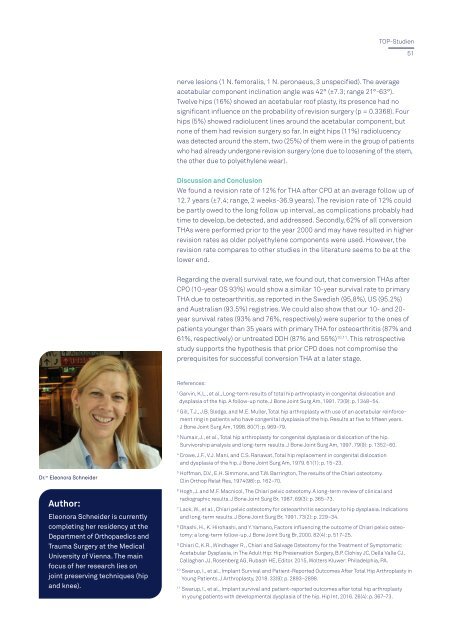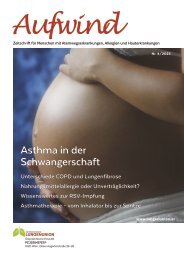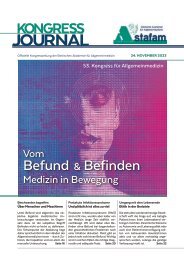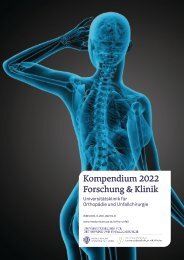Kompendium 2020 Forschung & Klinik
Das Kompendium 2020 der Universitätsklinik für Orthopädie und Unfallchirurgie von MedUni Wien und AKH Wien (o. Univ.-Prof. R. Windhager) stellt einen umfassenden Überblick über die medizinsichen Leistungen und auch die umfangreichen Forschungsfelder dar. Die Veröffentlichungen zeigen die klinische Relevanz und innovative Ansätze der einzelnen Forschungsrichtungen. Herausgeber: Universitätsklinik für Orthopädie und Unfallchirurgie MedUni Wien und AKH Wien Prof. Dr. R. Windhager ISBN 978-3-200-07715-7
Das Kompendium 2020 der Universitätsklinik für Orthopädie und Unfallchirurgie von MedUni Wien und AKH Wien (o. Univ.-Prof. R. Windhager) stellt einen umfassenden Überblick über die medizinsichen Leistungen und auch die umfangreichen Forschungsfelder dar. Die Veröffentlichungen zeigen die klinische Relevanz und innovative Ansätze der einzelnen Forschungsrichtungen.
Herausgeber: Universitätsklinik für Orthopädie und Unfallchirurgie
MedUni Wien und AKH Wien
Prof. Dr. R. Windhager
ISBN 978-3-200-07715-7
You also want an ePaper? Increase the reach of your titles
YUMPU automatically turns print PDFs into web optimized ePapers that Google loves.
TOP-Studien<br />
51<br />
nerve lesions (1 N. femoralis, 1 N. peronaeus, 3 unspecified). The average<br />
acetabular component inclination angle was 42° (±7.3; range 21°-63°).<br />
Twelve hips (16%) showed an acetabular roof plasty, its presence had no<br />
significant influence on the probability of revision surgery (p = 0.3368). Four<br />
hips (5%) showed radiolucent lines around the acetabular component, but<br />
none of them had revision surgery so far. In eight hips (11%) radiolucency<br />
was detected around the stem, two (25%) of them were in the group of patients<br />
who had already undergone revision surgery (one due to loosening of the stem,<br />
the other due to polyethylene wear).<br />
Discussion and Conclusion<br />
We found a revision rate of 12% for THA after CPO at an average follow up of<br />
12.7 years (±7.4; range, 2 weeks-36.9 years). The revision rate of 12% could<br />
be partly owed to the long follow up interval, as complications probably had<br />
time to develop, be detected, and addressed. Secondly, 62% of all conversion<br />
THAs were performed prior to the year 2000 and may have resulted in higher<br />
revision rates as older polyethylene components were used. However, the<br />
revision rate compares to other studies in the literature seems to be at the<br />
lower end.<br />
Regarding the overall survival rate, we found out, that conversion THAs after<br />
CPO (10-year OS 93%) would show a similar 10-year survival rate to primary<br />
THA due to osteoarthritis, as reported in the Swedish (95,8%), US (95.2%)<br />
and Australian (93.5%) registries. We could also show that our 10- and 20-<br />
year survival rates (93% and 76%, respectively) were superior to the ones of<br />
patients younger than 35 years with primary THA for osteoarthritis (87% and<br />
61%, respectively) or untreated DDH (87% and 55%) 10,11 . This retrospective<br />
study supports the hypothesis that prior CPO does not compromise the<br />
prerequisites for successful conversion THA at a later stage.<br />
References:<br />
1<br />
Garvin, K.L., et al., Long-term results of total hip arthroplasty in congenital dislocation and<br />
dysplasia of the hip. A follow-up note. J Bone Joint Surg Am, 1991. 73(9): p. 1348–54.<br />
2<br />
Gill, T.J., J.B. Sledge, and M.E. Muller, Total hip arthroplasty with use of an acetabular reinforcement<br />
ring in patients who have congenital dysplasia of the hip. Results at five to fifteen years.<br />
J Bone Joint Surg Am, 1998. 80(7): p. 969–79.<br />
3<br />
Numair, J., et al., Total hip arthroplasty for congenital dysplasia or dislocation of the hip.<br />
Survivorship analysis and long-term results. J Bone Joint Surg Am, 1997. 79(9): p. 1352–60.<br />
4<br />
Crowe, J.F., V.J. Mani, and C.S. Ranawat, Total hip replacement in congenital dislocation<br />
and dysplasia of the hip. J Bone Joint Surg Am, 1979. 61(1): p. 15–23.<br />
Dr. in Eleonora Schneider<br />
5<br />
Hoffman, D.V., E.H. Simmons, and T.W. Barrington, The results of the Chiari osteotomy.<br />
Clin Orthop Relat Res, 1974(98): p. 162–70.<br />
6<br />
Hogh, J. and M.F. Macnicol, The Chiari pelvic osteotomy. A long-term review of clinical and<br />
Author:<br />
Eleonora Schneider is currently<br />
completing her residency at the<br />
Department of Orthopaedics and<br />
Trauma Surgery at the Medical<br />
University of Vienna. The main<br />
focus of her research lies on<br />
joint preserving techniques (hip<br />
and knee).<br />
radiographic results. J Bone Joint Surg Br, 1987. 69(3): p. 365–73.<br />
7<br />
Lack, W., et al., Chiari pelvic osteotomy for osteoarthritis secondary to hip dysplasia. Indications<br />
and long-term results. J Bone Joint Surg Br, 1991. 73(2): p. 229–34.<br />
8<br />
Ohashi, H., K. Hirohashi, and Y. Yamano, Factors influencing the outcome of Chiari pelvic osteotomy:<br />
a long-term follow-up. J Bone Joint Surg Br, 2000. 82(4): p. 517–25.<br />
9<br />
Chiari C, K.R., Windhager R, , Chiari and Salvage Osteotomy for the Treatment of Symptomatic<br />
Acetabular Dysplasia, in The Adult Hip: Hip Preservation Surgery, B.P. Clohisy JC, Della Valle CJ,<br />
Callaghan JJ, Rosenberg AG, Rubash HE, Editor. 2015, Wolters Kluwer: Philadelphia, PA.<br />
10<br />
Swarup, I., et al., Implant Survival and Patient-Reported Outcomes After Total Hip Arthroplasty in<br />
Young Patients. J Arthroplasty, 2018. 33(9): p. 2893–2898.<br />
11<br />
Swarup, I., et al., Implant survival and patient-reported outcomes after total hip arthroplasty<br />
in young patients with developmental dysplasia of the hip. Hip Int, 2016. 26(4): p. 367–73.
















